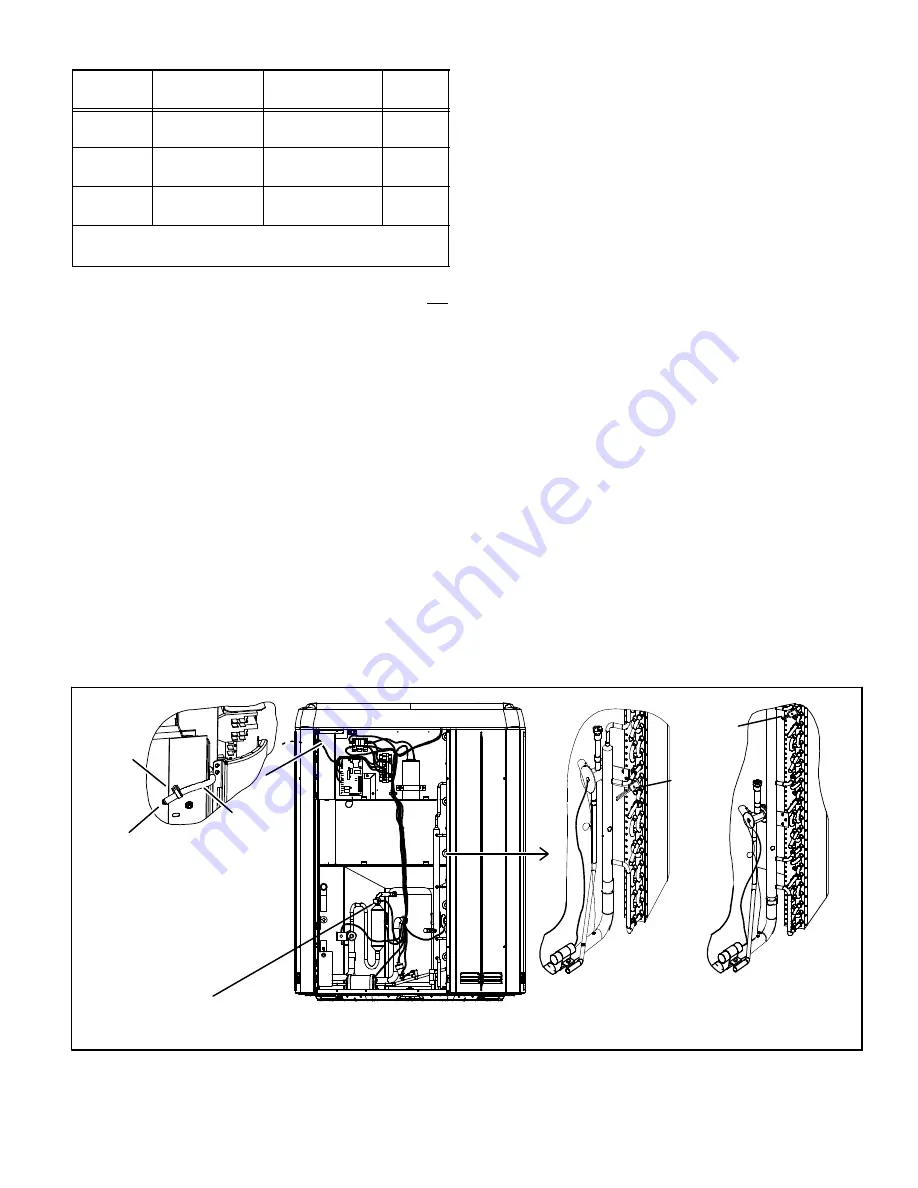
Page 25
XP19 SERIES
Table 13. Sensor Temperature / Resistance Range
Sensor
Temperature
Range °F (°C)
Resistance values
range (ohms)
Pins/Wire
Color
Outdoor
(Ambient)
−35 (−37) to 120
(48)
280,000 to 3750
3 and 4
(Black)
Coil
−35 (−37) to 120
(48)
280,000 to 3750
5 and 6
(Brown)
Discharge (if
applicable)
24 (−4) to 350
(176)
41,000 to 103
1 and 2
(Yellow)
NOTE
Sensor resistance decreases as sensed temperature
increases (see Figure 34).
NOTE When checking the ohms across a sensor, be
aware that a sensor showing a resistance value that is not
within the range shown in Table 13, may be performing as
designed. However, if a shorted or open circuit is detected,
then the sensor may be faulty and the sensor harness will
need to be replaced.
Defrost Coil Sensor (RT21)
This sensor (shown in
Figure 35, Detail A) considers outdoor temperatures below
−35°F (−37°C) or above 120°F (48°C) as a fault. If the
defrost coil sensor is detected as being open, shorted or
out of the temperature range of the sensor, the board will
not perform demand or time/temperature defrost
operation and will display the appropriate fault code.
Heating and cooling operation will be allowed in this fault
condition.
Discharge Line Sensor (RT28)
If this sensor exceeds
a temperature of 300°F (148°C) during compressor
operation, the board will de−energize the compressor
contactor output (and the defrost output, if active). The
compressor will remain off until the discharge temperature
has dropped below 225°F (107°C) and the 5-minute
anti−short cycle delay has been satisfied. This sensor has
two fault and lockout codes:
1. If the board recognizes five high discharge line
temperature faults during a single (Y1) compressor
demand, it reverts to a lockout mode and displays the
appropriate code. This code detects shorted sensor or
high discharge temperatures. Code on board is
Discharge Line Temperature Fault and Lockout
.
2. If the board recognizes five temperature sensor range
faults during a single (Y1) compressor demand, it
reverts to a lockout mode and displays the appropriate
code. The board detects open sensor or
out-of-temperature sensor range. This fault is
detected by allowing the unit to run for 90 seconds
before checking sensor resistance. If the sensor
resistance is not within range after 90 seconds, the
board will count one fault. After five faults, the board
will lockout. Code on board is
Discharge Sensor Fault
and Lockout
.
The discharge line sensor (see Figure 35), which covers a
range of 150°F (65°C) to 350°F (176°C), is designed to
mount on a
½
" refrigerant discharge line.
Ambient Sensor (RT13)
The ambient sensor (shown
in Figure 35, Detail B) considers outdoor temperatures
below −35°F (−37°C) or above 120°F (48°C) as a fault. If the
ambient sensor is detected as being open, shorted or out
of the temperature range of the sensor, the board will not
perform demand defrost operation. The board will revert to
time/temperature defrost operation and will display the
appropriate fault code. Heating and cooling operation will
be allowed in this fault condition.
NOTE Within a single room thermostat demand, if
5−strikes occur, the board will lockout the unit. DCB 24 volt
power
R
must be cycled OFF or the TEST pins on board
must be shorted between 1 to 2 seconds to reset the
board.
24 TUBES
UP
SLEEVE
AMBIENT SENSOR
− EXTEND TIP OF
PLASTIC SENSOR JUST OUTSIDE OF PLASTIC
SLEEVE.
PLACE AMBIENT SENSOR AND WIRE FROM
DCB INSIDE OF PLASTIC SLEEVE AND ROUTE
THROUGH GAP BETWEEN CORNER POST AND
COIL SUPPORT AS SHOWN. SECURE WITH
WIRE TIE.
WIRE TIE
MODELS −024 AND −036
MODELS −048 AND −060
12 TUBES
UP
COIL SENSOR
− CLIP COIL TEMPERATURE SENSOR FROM THE DCB ON THE RETURN BEND
SHOWN ON MODELS AS FOLLOWS:
DETAIL A
DETAIL B
DISCHARGE LINE
SENSOR
Figure 35. Sensor Locations








































